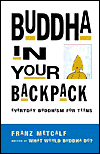
Image from Pixabay
What is meditation? Seems like it should be an easy question, but it's like asking what is love. There are so many aspects of it, so many perspectives on it, and so many ways to experience it that meditation doesn't lend itself to being reduced to one quick answer. The best I can do is this: Meditation means ways of making the mind understand itself.
I don't mean "understand" in an intellectual way, like the way a neuropsychologist understands patterns of brain activity. That's an understanding of facts but not an experience of inner knowing. Buddhist understanding starts inside and recognizes what is happening right here, right now, in our heads. Meditation helps you understand how and why your mind moves and thinks and wants by letting you see these things as they happen.
And meditation goes beyond this. You start with the rest of the Eightfold Path — or any other wise and compassionate way of being, such as other religions provide. When you then add meditation, you gain the power to change your mind. Literally. You can change how your mind works. Why change your mind? The usual reason is to get happier. When you use the tool of meditation to unlock the processes of your mind, you can reprogram yourself to get rid of greed, ignorance, and hatred, replacing them with calm, satisfaction, wisdom, love, and joy. Who wouldn't want that?
So why doesn't everyone meditate? Two main reasons. First, some people are taught that meditation is somehow unreligious and makes one susceptible to the influence of evil powers. I'm not kidding; this is the official position of the Roman Catholic Church as I write this book. This is such a fundamentally ignorant and harmful view it is best I don't say anything more about it. I don't want to get into wrong speech!
There's also a more understandable reason people avoid meditation: It can be really hard. Meditation is hard when we're resistant to it. Sometimes our minds don't want to let go of our hard-won sense of solidity and selfishness. We've been working on that sense of self since we were toddlers, and on some levels it's necessary for survival, so we cling to it. We also resist meditation when we'd rather have external amusement than internal happiness. This may sound stupid, like something nobody would ever want, but most of us feel like this all the time. Think about yourself honestly. Given a choice, don't you always feel immediate desire to do the most exciting, fun thing? If so, join the club; you're a human being.
The trouble is, that search for amusement and excitement never fully succeeds. In the end it always fails completely as we die. It cannot be the path to happiness. Real happiness is internal and it comes from changing your mind after learning how it works. Meditation can get you there because it reveals the workings of your mind and lets you fix them.
Because of their personal resistance to meditation, and because it takes time, energy, a quiet space, and a bit of knowledge, most people in the world don't meditate. Even most Buddhists don't meditate, and a person can be an excellent Buddhist without meditating. Yet most young people interested in Buddhism do meditate, and they're right to. For many people it provides the single strongest push forward on the path.
There's something immediately obvious about concepts like right speech and even right effort, but meditation is another story. It goes against all the thought habits most people have cultivated over their whole lives. Yet meditation produces immediate, positive results across the whole spectrum of body and mind. If you try it yourself, you'll quickly discover that meditation can produce benefits for you that range from eliminating stress to getting better grades. It may even help you wake up.
Calming Meditation
The many methods of Buddhist meditation all boil down to two main types. The first type is samatha, or calming meditation. It's not about putting yourself to sleep. That's not meditation; it's not even calm — think of how active your dreams can be. Samatha is more like concentrating your mind. This concentration is not like concentrating on a math problem or on driving. That's much too active and linear. Here, concentration means focusing thoughts on one unchanging thing, not for the purpose of doing anything with it, but simply to let it fill your whole mind.
Samatha calms the mind further and further until it reaches a place of true rest and ease called samadhi. (If samatha and samadhi sound alike, it's because they come from the same root, meaning "peace.") Buddhism shares this general type of meditation with other religions, especially Hinduism. When Siddhartha practiced meditation and self-mortification with the renunciants in the forest after he left home, he was working toward ever-deeper immersion in open and quiet meditative states. He was doing samatha meditation.
When doing samatha, you start by concentrating on a visual or mental object. You try to develop a one-pointed mind, free of the hindrances of ill-will, laziness, greed, and other such feelings. You purely concentrate on the object. After much practice, you can even let the object go and concentrate on internal experience. As you do so, your concentration strengthens, your calm deepens, and you find yourself more and more able to achieve this state each time you sit down to meditate. The process is not just some dry skill you acquire; it's enjoyable in a way that touches you more deeply than normal fleeting pleasures. Samatha gives you a foundation you can stay with as you look at the action in your mind. That looking is the other type of meditation.
Insight Meditation
"Insight" is the usual translation of vipassana, which literally means "clear sight." Buddhism attends to insight more than other religions do in their meditative paths.
When doing vipassana, you don't strive for calm. Instead your objective is insight. You look right into your mind to see how and why it's doing what it's doing. You begin to see how one thought leads to another and how an attitude or desire leads to a natural reaction that may or may not be good. When you see that actually happening in your mind, it really hits you: you need to change, and you have the power to do it. That power is the strongest thing in the world, and it's in you now. Insight meditation puts that power right in your hands.
Is it possible to get this power without meditation? Sure it is. Great spiritual people throughout time in all cultures have tapped into this power, and most of them were not Buddhists. They gained insight without Buddhist meditation, and so can you. Of course, each of them was a one-in-a-million person with fantastic powers of intellect, awareness, compassion, and mental discipline. Have you developed all those qualities? If not, maybe try meditation.
Reprinted with permission of the publisher,
Ulysses Press. ©2003. www.ulyssespress.com
Article Source
Buddha In Your Backpack: Everyday Buddhism for Teens
by Franz Metcalf.
 A guide for navigating the teen years, Buddha in Your Backpack is for young people who want to learn more about Buddhism or for those who simply want to understand what’s going on inside themselves and in the world around them.
A guide for navigating the teen years, Buddha in Your Backpack is for young people who want to learn more about Buddhism or for those who simply want to understand what’s going on inside themselves and in the world around them.
About the Author
 Franz Metcalf did his Masters work at the Graduate Theological Union, and received his doctorate from the University of Chicago with a dissertation on the question, "Why Do Americans Practice Zen Buddhism?" He currently works with the Forge Institute for Spirituality and Social Change, co-chairs the steering committee of the Person, Culture, and Religion Group of the American Academy of Religion, and teaches college in Los Angeles. He has contributed reviews and chapters to various scholarly publications and is review editor of the Journal of Global Buddhism. He's the author of What Would Buddha Do? and co-author of What Would Buddha Do at Work? If you want to learn more about Franz (and other Buddhist things), visit his web site at: www.mind2mind.net
Franz Metcalf did his Masters work at the Graduate Theological Union, and received his doctorate from the University of Chicago with a dissertation on the question, "Why Do Americans Practice Zen Buddhism?" He currently works with the Forge Institute for Spirituality and Social Change, co-chairs the steering committee of the Person, Culture, and Religion Group of the American Academy of Religion, and teaches college in Los Angeles. He has contributed reviews and chapters to various scholarly publications and is review editor of the Journal of Global Buddhism. He's the author of What Would Buddha Do? and co-author of What Would Buddha Do at Work? If you want to learn more about Franz (and other Buddhist things), visit his web site at: www.mind2mind.net
Video/Presentation by Franz Metcalf & BJ Gallagher: "Being Buddha at Work"
{vembed Y=yFQQg-T-iDs}




























